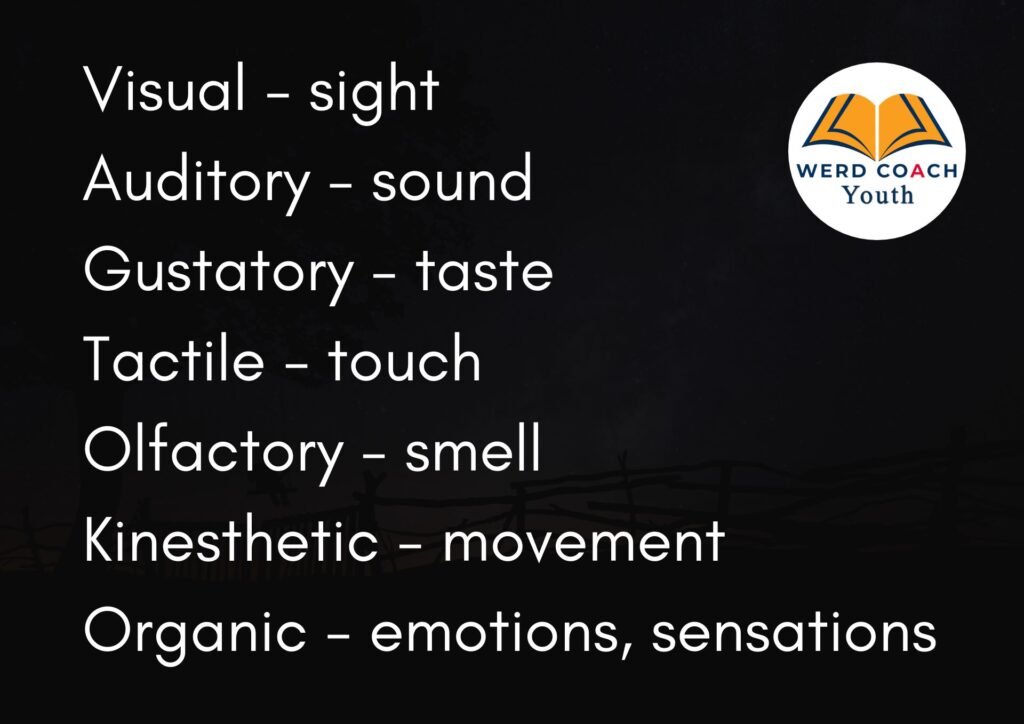Descriptive language is all about making words come alive. It’s a writer’s attempt to make you see, and feel, and smell, and hear, and taste the world he or she is describing to you. It’s about using vivid, sensory language. Of all the literary devices writers have at their disposal, it’s this one which gets me the most excited because this is what breathes life into stories.
This installment of our comprehension series takes a look at the different types of imagery and how understanding each type can increase reading comprehension skills. And just as with all the previous installments, this knowledge works with developing writing skills as well.

Using descriptive words helps writers paint a picture in readers’ minds, almost like putting together a jigsaw puzzle. We all experience the world around us through our senses and emotions, so when writers provide such details, they are filling in bits and pieces of the world to help readers move beyond the pages into something more tangible.
The words we choose to describe our experiences say a lot about who we are and what we think. Remember, writing is communication and when a writer chooses one word over another, he or she is giving us information with that choice. For example, read the following sentences and think about the impact each makes on you.
* Wow, she has a tremendous amount of energy.
* Wow, she has a lot of energy.
Both sentences carry the same general meaning, but the use of the words “tremendous amount” takes readers to a different place, a different level of sophistication. Don’t you think or feel differently about the speakers?
Vivid language can convey what authors feel or believe about a thing without them having to say their thoughts outright. It also connects readers with authors by giving insight into the authors themselves.
The two types of descriptive words most people are familiar with are called adverbs and adjectives. Adverbs describe verbs, and adjectives describe nouns.
ADVERB: He drives carefully through the neighbourhood.
The word “adorable” describes the puppy.
The thing with adjectives and adverbs, however, is that their interpretation is subjective. More detailed descriptive language gives readers evidence rather than just the writer’s opinion.
“After coming to a complete stop at the Stop sign, he leaned forward and looked left, then right, before pressing on the gas pedal just enough to move the car forward at a snail’s pace. He peered through the window now and then, as if looking for someone or something.”
“With huge brown eyes, soft, golden-brown fur, and large floppy ears, there was so much to love about the puppy.”
Now we know why the writers made the claims they did. In comprehension exercises, questions such as “What words show that the man drove carefully?” and “How does the writer describe the puppy?” are common. There may also be
questions such as “Why do you think the man ‘peered through the window now and then’?” and “How do you think the writer feels about the puppy? Give a reason for your answer.”
In order to answer such questions, readers must form a mental picture of what’s happening in the passage and put themselves in the position of the writer. Understanding imagery helps with that.

Most people are familiar with the first five types of imagery which target the five senses. While they may not know the literary names, they know about sight, sound, taste, touch, and smell. The last two are the more unfamiliar ones, and those are the ones that make writing exciting and engage audiences.
Movement is often described by giving details of what we see, so it’s technically an aspect of visual imagery. However, there are different considerations as we’re not simply describing stationary objects and must account for motion.
Organic Imagery is one that many people don’t think about as a form of imagery. It deals with physical sensations and emotions. Sometimes we group all under the category of ‘feelings’, but they are separate concepts. Physical sensations refer to experiences such as hunger, thirst, pain, and all their variations. Emotions refer to anger, sadness, happiness, fear, and all their variations.
Describing emotions and sensations can be challenging because these experiences are personal and often occur inside the body where others can’t see what’s happening. Using similes, metaphors, personification, and other literary devices help make these invisible experiences relatable.

When learning about descriptive language, a great place to start is building vocabulary of adjectives and adverbs. It’s important, however, to encounter the words in context so that the meaning and usage are clear. The best way to do that is by reading and discussing what was read, and the best way to get children excited about this type of language is for them to experience it.
This is where an integrated, multi-sensory approach makes a difference.
There are some children who are unable to visualize experiences easily, and some who aren’t able to do it at all. When you tell them “close your eyes and tell me what you see”, invariably they would respond “black” or “dancing light”. Their ‘mind’s eye’ needs guidance.
Bringing these abstract concepts of imagery into the physical world will help these children experience words and language in ways they’ve never been able to. And, children who can visualize words and ideas easily will have fun while making tangible connections.
Here are a few ideas to help you along:
1. Visual Imagery – use artwork to have children depict their understanding of words.
2. Auditory Imagery – have children make sounds and describe them.
3. Gustatory Imagery – do a taste test of a variety of flavors.
4. Tactile Imagery – invite a wildlife sanctuary or zoo to have children interact with the animals (also works for auditory and olfactory, as many animals make noises and have peculiar smells).
5. Olfactory Imagery – engage in a laboratory-style smell test, with both pleasant and unpleasant smells.
6. Kinesthetic Imagery – charades is one of the best games to explore movement.
7. Organic Imagery – art, music, and movement can all be incorporated here to help children find words to explain how they feel (emotions and sensations).



